The Effect of Stereoregularity and Adding Irganox 1076 on the Physical Aging Behavior of Poly(1-trimetylsilyl-1-propyne)
Abstract
:1. Introduction
2. Materials and Methods
2.1. Materials
2.2. PTMSP Synthesis and Characterization
2.3. Preparation of Polymer Films
2.4. Investigation of Films by X-ray Diffraction
2.5. Transport Properties Determination
2.5.1. Gas Permeability Measurement Method
2.5.2. Gas Solubility Measurement Method
3. Results and Discussion
3.1. Polymer Properties
3.2. Effect of the PTMSP Microstructure on Gas Transport Properties
3.3. Effect of Aging on the Gas Transport Properties of PTMSP Films
4. Conclusions
Author Contributions
Funding
Institutional Review Board Statement
Conflicts of Interest
References
- Masuda, T. Substituted polyacetylenes: Synthesis, properties, and functions. Polym. Rev. 2017, 57, 1–14. [Google Scholar] [CrossRef]
- Nagai, K.; Masuda, T.; Nakagawa, T.; Freeman, B.D.; Pinnau, I. Poly [1-(trimethylsilyl)-1-propyne] and related polymers: Synthesis, properties and functions. Prog. Polym. Sci. 2001, 26, 721–798. [Google Scholar] [CrossRef]
- Pinnau, I.; Toy, L.G. Transport of organic vapors through poly (1-trimethylsilyl-1-propyne). J. Membr. Sci. 1996, 116, 199–209. [Google Scholar] [CrossRef]
- Morisato, A.; Freeman, B.D.; Pinnau, I.; Casillas, C.G. Pure hydrocarbon sorption properties of poly (1-trimethylsilyl-1-propyne)(PTMSP), poly (1-phenyl-1-propyne)(PPP), and PTMSP/PPP blends. J. Polym. Sci. Part B Polym. Phys. 1996, 34, 1925–1934. [Google Scholar] [CrossRef]
- Masuda, T.; Isobe, E.; Higashimura, T.; Takada, K. Poly [1-(trimethylsilyl)-1-propyne]: A new high polymer synthesized with transition-metal catalysts and characterized by extremely high gas permeability. J. Am. Chem. Soc. 1983, 105, 7473–7474. [Google Scholar] [CrossRef]
- Plate, N.A.; Bokarev, A.K.; Kaliuzhnyi, N.E.; Litvinova, E.G.; Khotimskii, V.S.; Volkov, V.V.; Yampol’skii, Y.P. Gas and vapor permeation and sorption in poly (trimetylsilylpropyne). J. Membr. Sci. 1991, 60, 13–24. [Google Scholar] [CrossRef]
- Nagai, K.; Nakagawa, T. Effects of aging on the gas permeability and solubility in poly (1-trimethylsilyl-1-propyne) membranes synthesized with various catalysts. J. Membr. Sci. 1995, 105, 261–272. [Google Scholar] [CrossRef]
- Starannikova, L.; Khodzhaeva, V.; Yampolskii, Y. Mechanism of aging of poly [1-(trimethylsilyl)-1-propyne] and its effect on gas permeability. J. Membr. Sci. 2004, 244, 183–191. [Google Scholar] [CrossRef]
- Wang, X.Y.; Willmore, F.T.; Raharjo, R.D.; Wang, X.; Freeman, B.D.; Hill, A.J.; Sanchez, I.C. Molecular simulations of physical aging in polymer membrane materials. J. Phys. Chem. B 2006, 110, 16685–16693. [Google Scholar] [CrossRef]
- Lau, C.H.; Mulet, X.; Konstas, K.; Doherty, C.M.; Sani, M.A.; Separovic, F.; Hill, M.R.; Wood, C.D. Hypercrosslinked Additives for Ageless Gas-Separation Membranes. Angew. Chem. Int. Ed. Engl. 2016, 55, 1998–2001. [Google Scholar] [CrossRef]
- Levita, G.; Struik, L.C.E. Physical ageing in rigid chain polymers. Polymer 1983, 24, 1071–1074. [Google Scholar] [CrossRef]
- Grigoriadi, K.; Westrik, J.B.; Vogiatzis, G.G.; van Breemen, L.C.; Anderson, P.D.; Hütter, M. Physical ageing of polystyrene: Does tacticity play a role? Macromolecules 2019, 52, 5948–5954. [Google Scholar] [CrossRef]
- Frieberg, B.R.; Glynos, E.; Sakellariou, G.; Tyagi, M.; Green, P.F. Effect of molecular stiffness on the physical aging of polymers. Macromolecules 2020, 53, 7684–7690. [Google Scholar] [CrossRef]
- Low, Z.X.; Budd, P.M.; McKeown, N.B.; Patterson, D.A. Gas permeation properties, physical aging, and its mitigation in high free volume glassy polymers. Chem. Rev. 2018, 118, 5871–5911. [Google Scholar] [CrossRef]
- Nakaoki, T.; Kobayashi, M. Local conformation of glassy polystyrenes with different stereoregularity. J. Mol. Struct. 2003, 655, 343–349. [Google Scholar] [CrossRef]
- Masuda, T.; Higashimura, T. Polyacetylenes with substituents: Their synthesis and properties. In: Catalytical and Radical Polymerization. Adv. Polym. Sci. 1987, 81, 121–165. [Google Scholar]
- Costa, G.; Grosso, A.; Sacchi, M.C.; Stein, P.C.; Zetta, L. A study by solid-state and solution carbon-13 NMR on silicon-containing polyacetylenes. Macromolecules 1991, 24, 2858–2861. [Google Scholar] [CrossRef]
- Izumikawa, H.; Masuda, T.; Higashimura, T. Study on the geometric structure of poly [1-(trimethylsilyl)-1-propyne] by 13 C and 29 Si NMR spectroscopies. Polym. Bull. 1991, 27, 193–199. [Google Scholar] [CrossRef]
- Khotimsky, V.S.; Tchirkova, M.V.; Litvinova, E.G.; Rebrov, A.I.; Bondarenko, G.N. Poly [1-(trimethylgermyl)-1-propyne] and poly [1-(trimethylsilyl)-1-propyne] with various geometries: Their synthesis and properties. J. Polym. Sci. Part A Polym. Chem 2003, 41, 2133–2155. [Google Scholar] [CrossRef]
- Hill, A.J.; Pas, S.J.; Bastow, T.J.; Burgar, M.I.; Nagai, K.; Toy, L.G.; Freeman, B.D. Influence of methanol conditioning and physical aging on carbon spin-lattice relaxation times of poly (1-trimethylsilyl-1-propyne). J. Membr. Sci. 2004, 243, 37–44. [Google Scholar] [CrossRef]
- Matson, S.M.; Kossov, A.A.; Makrushin, V.P.; Levin, I.S.; Zhilyaeva, N.A.; Litvinova, E.G.; Khotimskiy, V.S. Synthesis, Structure and Properties of Poly (1-Trimethylsilyl-1-Propyne) Obtained with NbBr 5-and TaBr 5-Based Catalytic Systems. Polym. Sci. Ser. C 2019, 61, 76–85. [Google Scholar] [CrossRef]
- Nagai, K.; Freeman, B.D.; Hill, A.J. Effect of physical aging of poly (1-trimethylsilyl-1-propyne) films synthesized with TaCl5 and NbCl5 on gas permeability, fractional free volume, and positron annihilation lifetime spectroscopy parameters. J. Polym. Sci. Part B Polym. Phys. 2000, 38, 1222–1239. [Google Scholar] [CrossRef]
- Merkel, T.C.; He, Z.; Pinnau, I.; Freeman, B.D.; Meakin, P.; Hill, A.J. Effect of nanoparticles on gas sorption and transport in poly (1-trimethylsilyl-1-propyne). Macromolecules 2003, 36, 6844–6855. [Google Scholar] [CrossRef]
- Yave, W.; Shishatskiy, S.; Abetz, V.; Matson, S.; Litvinova, E.; Khotimskiy, V.; Peinemann, K.V. A Novel Poly (4-methyl-2-pentyne)/TiO2 Hybrid Nanocomposite Membrane for Natural Gas Conditioning: Butane/Methane Separation. Macromol. Chem. Phys. 2007, 208, 2412–2418. [Google Scholar] [CrossRef]
- Olivieri, L.; Meneguzzo, S.; Ligi, S.; Saccani, A.; Giorgini, L.; Orsini, A.; Pettinau, A.; De Angelis, M.G. Reducing ageing of thin PTMSP films by incorporating graphene and graphene oxide: Effect of thickness, gas type and temperature. J. Membr. Sci. 2018, 555, 258–267. [Google Scholar] [CrossRef]
- Bakhtin, D.S.; Kulikov, L.A.; Legkov, S.A.; Khotimskiy, V.S.; Levin, I.S.; Borisov, I.L.; Maksimov, A.L.; Volkov, V.V.; Karakhanov, E.A.; Volkov, A.V. Aging of thin-film composite membranes based on PTMSP loaded with porous aromatic frameworks. J. Membr. Sci. 2018, 554, 211–220. [Google Scholar] [CrossRef]
- Shishatskiy, S.; Makrushin, V.; Levin, I.; Merten, P.; Matson, S.; Khotimskiy, V. Effect of Immobilization of Phenolic Antioxidant on Thermo-Oxidative Stability and Aging of Poly (1-trimethylsilyl-1-propyne) in View of Membrane Application. Polymers 2022, 14, 462. [Google Scholar] [CrossRef]
- Litvinova, E.G.; Melekhov, V.M.; Petrushanskaya, N.V.; Rosheva, G.V.; Fedotov, V.B.; Feldblum, V.S.; Khotimskiy, V.S. Method for producing trimethylsilylpropyne. Patent 1823457 of Russian Federation, 20 August 1995. [Google Scholar]
- Bezgin, D.A.; Nikiforov, R.Y.; Belov, N.A.; Milenin, S.; Yampolskii, Y.P.; Muzafarov, A.M. Synthesis and Gas Transport Parameters of a Carbosilane Dendrimer. Membr. Membr. Technol. 2021, 3, 1–7. [Google Scholar] [CrossRef]
- Dorkenoo, K.D.; Pfromm, P.H. Accelerated physical aging of thin poly [1-(trimethylsilyl)-1-propyne] films. Macromolecules 2000, 33, 3747–3751. [Google Scholar] [CrossRef]
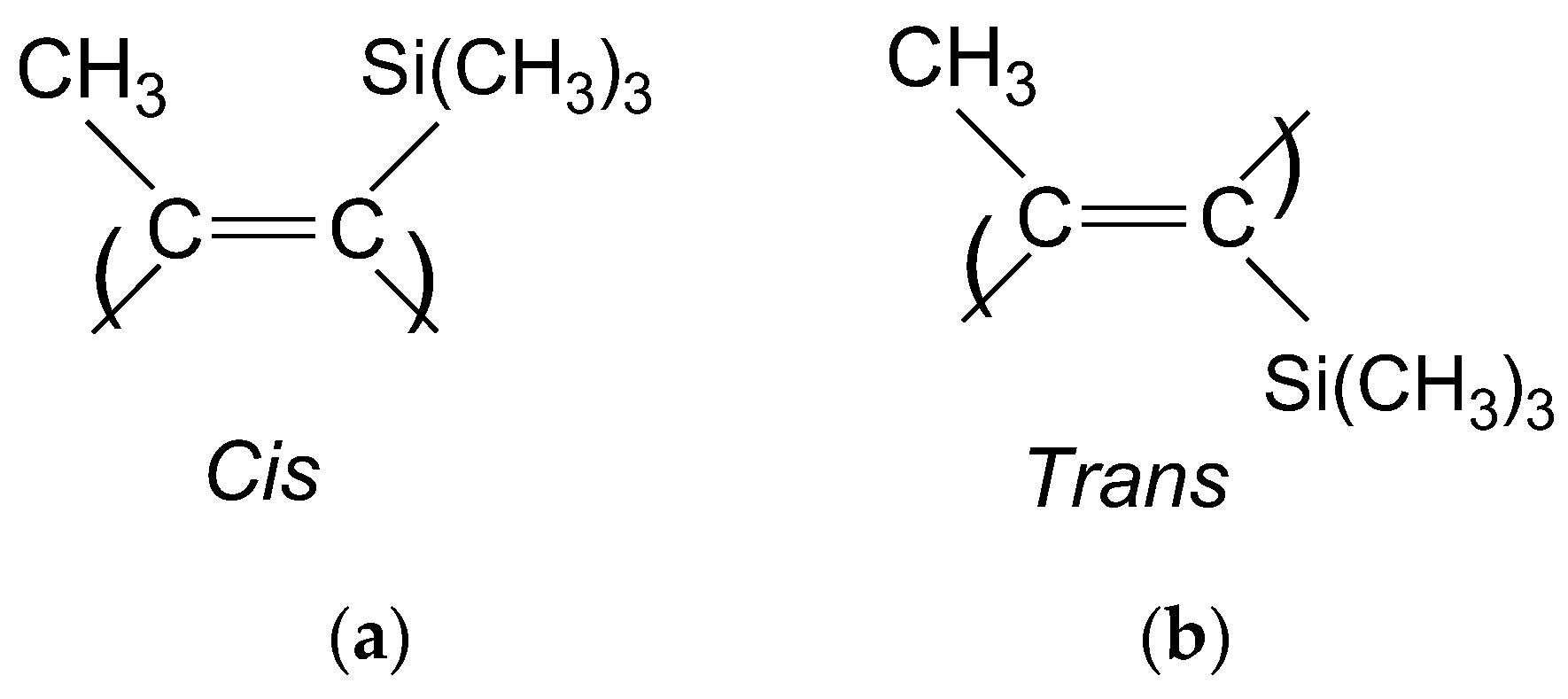
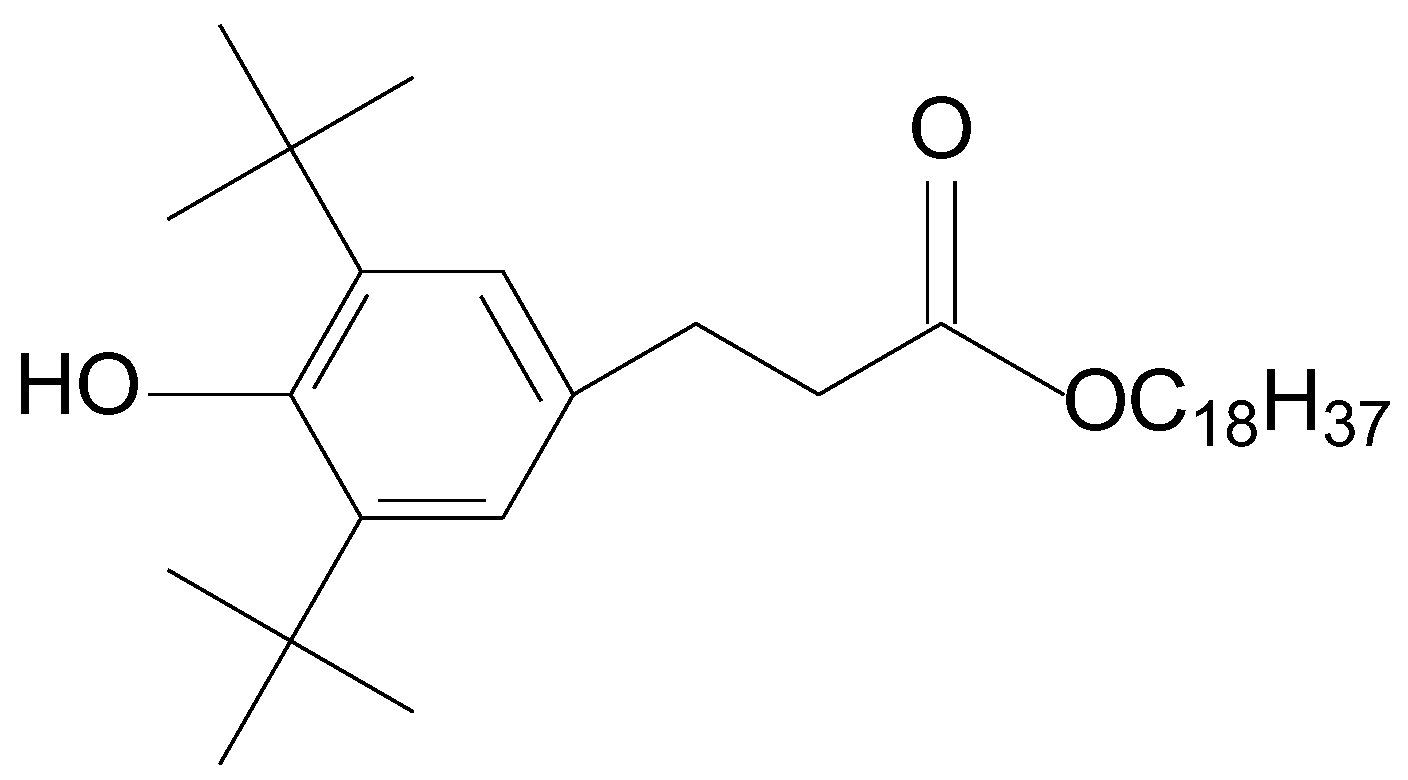





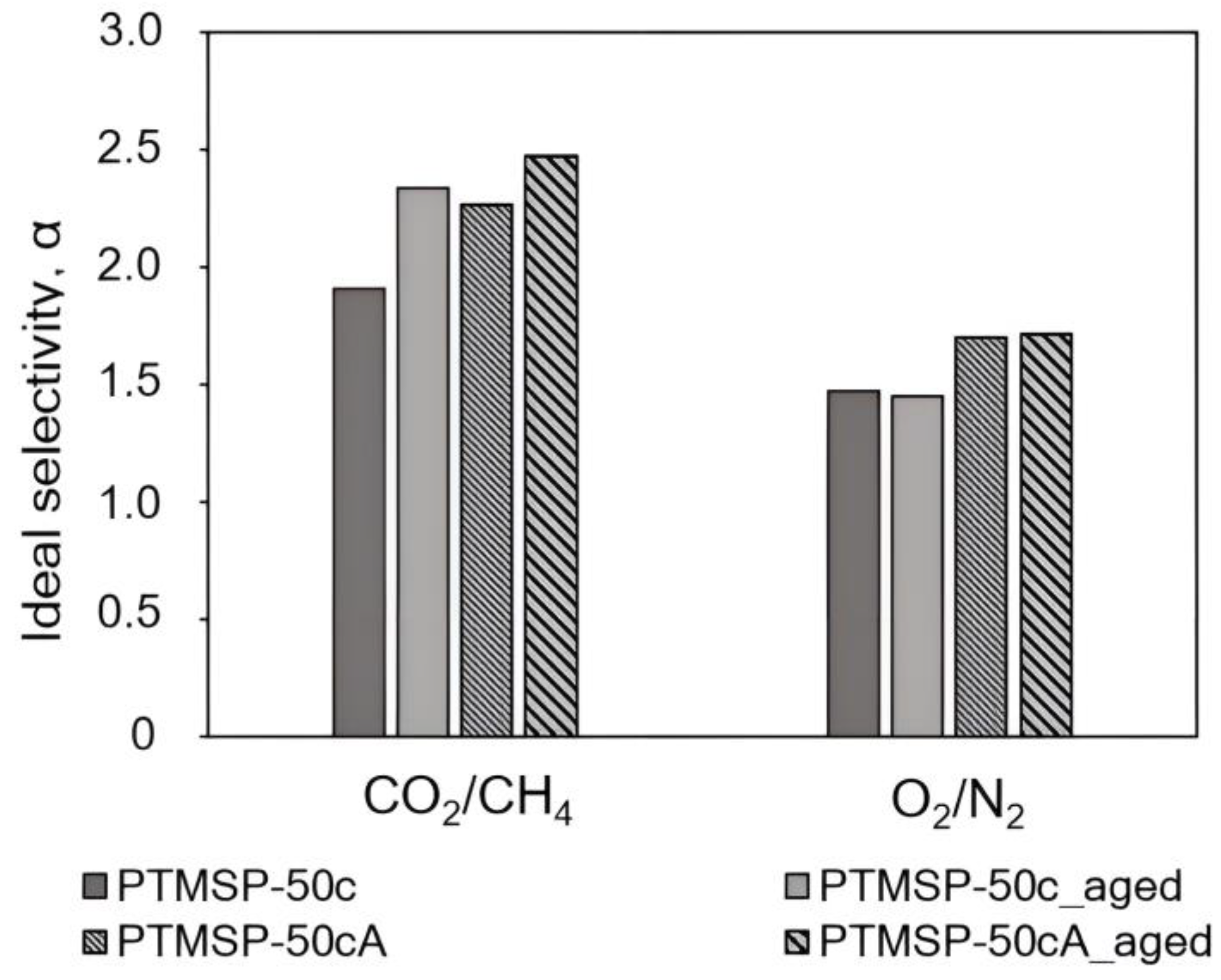
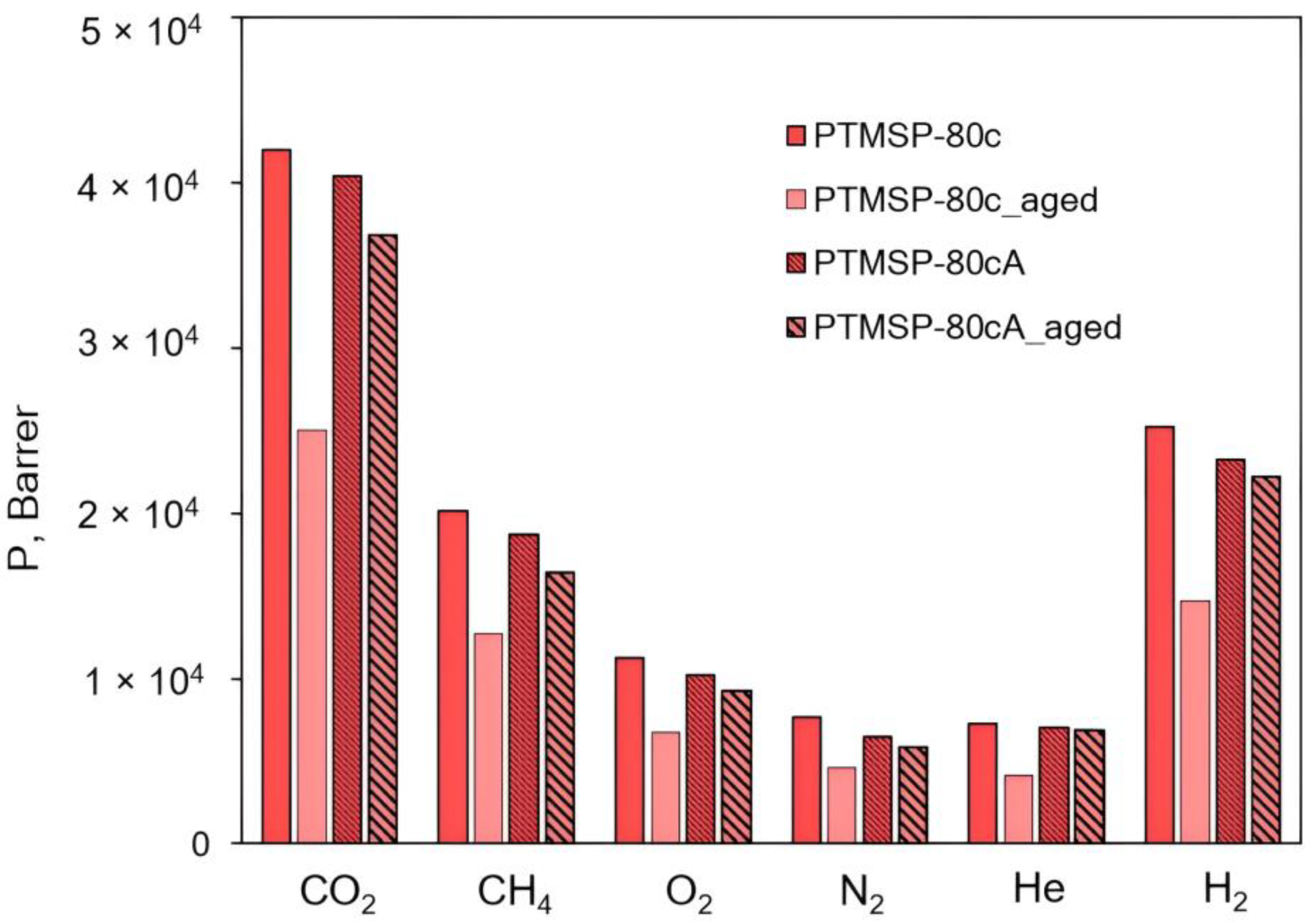


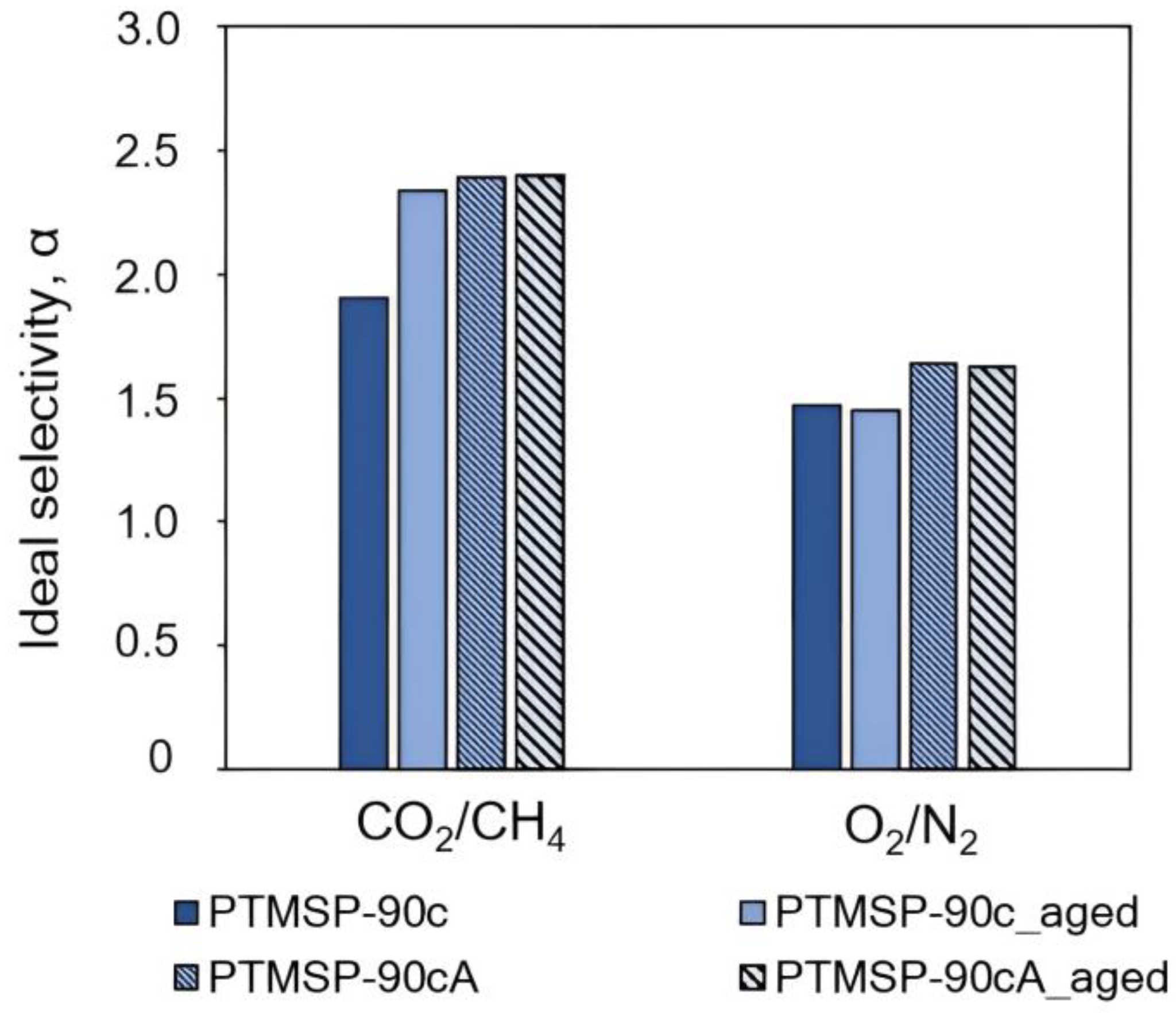
| Sample | Catalytic System 1 | Yield, % | [η], dL/g | Cis-Content, % |
|---|---|---|---|---|
| PTMSP-50c | NbCl5 | 90 | 0.7 | 50 |
| PTMSP-80c | NbBr5/Ph4Sn | 70 | 2.7 | 80 |
| PTMSP-90c | NbBr5/n-Bu4Sn | 80 | 3.0 | 90 |
| Sample | Permeability Coefficient, P, Barrer * | |||||
|---|---|---|---|---|---|---|
| CO2 | CH4 | O2 | N2 | He | H2 | |
| PTMSP-50c | 43,500 | 19,000 | 10,900 | 6820 | 6100 | 20,700 |
| PTMSP-80c | 42,000 | 20,100 | 11,200 | 7630 | 7290 | 25,200 |
| PTMSP-90c | 50,900 | 26,700 | 14,600 | 9950 | 8230 | 29,000 |
| Sample | Ideal Selectivity, α | |||
|---|---|---|---|---|
| CO2/CH4 | CO2/N2 | O2/N2 | H2/CH4 | |
| PTMSP-50c | 2.3 | 6.4 | 1.6 | 1.1 |
| PTMSP-80c | 2.1 | 5.5 | 1.5 | 1.3 |
| PTMSP-90c | 1.9 | 5.1 | 1.5 | 1.1 |
| Sample | Cis-Content, % | Δ1/2 ° | d, Å | ||||
|---|---|---|---|---|---|---|---|
| PTMSP-50c | 50 | 3.5 | 8.83 | 4.43 | 3.17 | --- | --- |
| PTMSP-80c | 80 | 3.2 | 8.90 | 4.57 | 3.27 | --- | --- |
| PTMSP-90c | 90 | 3.4 | 9.01 | 4.53 | 3.21 | 2.46 | 2.03 |
| Gas | P 1 | D 2 | S 3 | P 1 | D 2 | S 3 | P 1 | D 2 | S 3 |
|---|---|---|---|---|---|---|---|---|---|
| PTMSP-50c_aged | PTMSP-80c_aged | PTMSP-90c_aged | |||||||
| CO2 | 19.7 | 1.6 | 127 | 25.0 | 2.6 | 97 | 43.0 | 4.6 | 92 |
| CH4 | 8.9 | 1.9 | 47 | 12.7 | 4.2 | 30 | 18.1 | 4.7 | 39 |
| O2 | 5.0 | 3.6 | 14 | 6.8 | 4.8 | 14 | 10.0 | 7.5 | 13 |
| N2 | 3.1 | 2.9 | 11 | 4.6 | 4.0 | 12 | 7.2 | 6.3 | 11 |
| He | 3.2 | - | - | 4.2 | - | - | 8.0 | - | - |
| H2 | 11.2 | - | - | 14.7 | - | - | 27.1 | - | - |
| PTMSP-50cA_aged | PTMSP-80cA_aged | PTMSP-90cA_aged | |||||||
| CO2 | 26.0 | 2.8 | 93 | 36.8 | 4.2 | 95 | 34.0 | 3.5 | 98 |
| CH4 | 11.5 | 3.3 | 35 | 16.4 | 4.0 | 31 | 14.2 | 3.4 | 42 |
| O2 | 6.4 | 6.2 | 12 | 9.2 | 6.6 | 14 | 8.8 | 6.1 | 14 |
| N2 | 3.8 | 3.7 | 8.7 | 5.8 | 13 | 12.7 | 5.4 | 4.5 | 11 |
| He | 5.8 | - | - | 6.9 | - | - | 6.2 | - | - |
| H2 | 18.7 | - | - | 22.2 | - | - | 21.5 | - | - |
Disclaimer/Publisher’s Note: The statements, opinions and data contained in all publications are solely those of the individual author(s) and contributor(s) and not of MDPI and/or the editor(s). MDPI and/or the editor(s) disclaim responsibility for any injury to people or property resulting from any ideas, methods, instructions or products referred to in the content. |
© 2023 by the authors. Licensee MDPI, Basel, Switzerland. This article is an open access article distributed under the terms and conditions of the Creative Commons Attribution (CC BY) license (https://creativecommons.org/licenses/by/4.0/).
Share and Cite
Makrushin, V.; Kossov, A.; Polevaya, V.; Levin, I.; Bezgin, D.; Syrtsova, D.; Matson, S. The Effect of Stereoregularity and Adding Irganox 1076 on the Physical Aging Behavior of Poly(1-trimetylsilyl-1-propyne). Polymers 2023, 15, 2172. https://doi.org/10.3390/polym15092172
Makrushin V, Kossov A, Polevaya V, Levin I, Bezgin D, Syrtsova D, Matson S. The Effect of Stereoregularity and Adding Irganox 1076 on the Physical Aging Behavior of Poly(1-trimetylsilyl-1-propyne). Polymers. 2023; 15(9):2172. https://doi.org/10.3390/polym15092172
Chicago/Turabian StyleMakrushin, Vladimir, Anton Kossov, Viktoriya Polevaya, Ivan Levin, Denis Bezgin, Dariya Syrtsova, and Samira Matson. 2023. "The Effect of Stereoregularity and Adding Irganox 1076 on the Physical Aging Behavior of Poly(1-trimetylsilyl-1-propyne)" Polymers 15, no. 9: 2172. https://doi.org/10.3390/polym15092172
APA StyleMakrushin, V., Kossov, A., Polevaya, V., Levin, I., Bezgin, D., Syrtsova, D., & Matson, S. (2023). The Effect of Stereoregularity and Adding Irganox 1076 on the Physical Aging Behavior of Poly(1-trimetylsilyl-1-propyne). Polymers, 15(9), 2172. https://doi.org/10.3390/polym15092172






